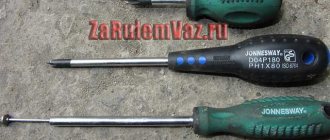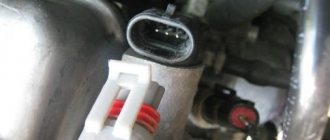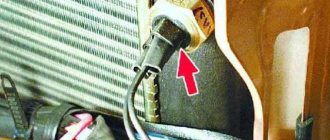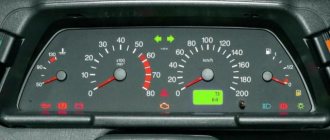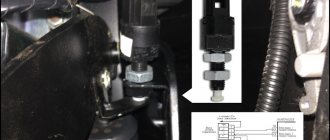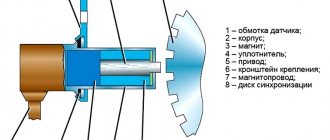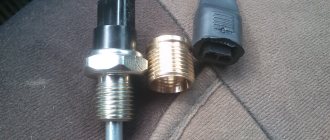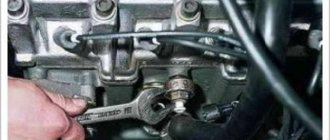The camshaft position sensor (possible names - camshaft position sensor, phase sensor, Hall sensor) is an electronic device that monitors the technical characteristics of the engine, and is also part of the electronic engine management system.
It is designed to determine the angular position of the camshaft, in accordance with the position of the crankshaft. The information that comes from the DPRV is read by the electronic engine control unit to control fuel injection and ignition. As a rule, the DPRV is functionally connected to the crankshaft speed sensor, which is located on its pulley.
Area of application: modern injection gasoline or diesel internal combustion engines.
In what cases is it necessary to replace the camshaft sensor and oil seal?
As for the camshaft pulley sensor, you can understand when it should be replaced if:
- There were difficulties starting the engine. In addition, the car cannot accelerate as quickly as it once did before. It is not possible to gain more than 3.5 thousand revolutions, as evidenced by the tachometer readings on the dashboard. This occurs when engine fluid leaks from the engine valve cover. Deposits appear on the sensor, which also get here from the timing belt.
- If the device fails during a trip, the car will still work, but after the engine stops, it will no longer be possible to start it. If the motor is running, then everything is fine with the device.
- Engine vibrations appeared while driving. The control unit will give the driver signals about a sensor malfunction.
VAZ 2110 car
This is relevant for VAZ 2110 engines with 8 and 16 valves. As for the oil seal, its failure can also be indicated by oil stains that appear on the engine and other related elements. In addition, a knock may indicate this. In particular, knocking can come from valves. If the knocking is constant, then the problem is in the seal.
In addition, a fairly noticeable noise may indicate a malfunction of the timing pulley itself. Therefore, it is necessary to listen to the knock.
This is interesting: What does blue smoke from the exhaust pipe mean?
The phase sensor has failed: how to determine
Like any other part, the phase sensor can fail. There are many reasons for this. Quite often the part simply wears out. It is not difficult to identify this problem. Just take a close look at how the car works. He himself will tell you about his breakdown.
If we talk about obvious signs, they will appear after you turn on the ignition. The engine will turn the starter for a few seconds. After this, the usual starting of the engine and activation of the ainge check will not occur.
Since the sensor will not transmit the necessary readings to the electronic engine unit. The engine will operate only on what the ignition indicates.
Another symptom that is often encountered is a faulty diagnostic system. It allows you to independently determine the condition of the vehicle. In this case, it will also fail and will not reproduce any data, since it will not be able to perform its main function.
Changing the oil seal
Below is a step-by-step manual for changing the camshaft oil seal for a VAZ 2110 car. The instructions are relevant for 16- and 8-valve engines. If you notice a new knocking noise coming from the camshaft, then, apparently, you need to disassemble it. Most likely, the knocking will go away after replacing the element. The part itself must be purchased in accordance with the manufacturer's specifications.
As for the characteristics themselves, the component must correspond to the dimensions of the part installed in a given car model. If the specifications are not met, you may have to go to the store for a new oil seal in the midst of repairs.
We change it with our own hands
- First of all, you should dismantle the timing belt of the VAZ 2110.
- Then you will need a "17" wrench. Take the tool and begin to unscrew the screw that secures the toothed disk of the timing pulley. You need to make sure that the pulley does not turn. To do this, you will need to pass a “10” head through the hole in it, which must be put on an extension cord. Engage the nut securing the rear cover of the timing belt drive.
- After this, using a screwdriver, pry up the timing pulley disk and dismantle it. At this moment, be careful: under no circumstances should the toothed disk key be lost. Remove it from its installation location.
- Now, using the same screwdriver, pry up the camshaft oil seal that needs to be replaced and remove it.
- Take a new oil seal and lubricate its edge and installation location with engine fluid. If you do not lubricate the element itself with oil, the knocking may not go away. To install the component you will need a small piece of pipe. The oil seal will need to be pressed in carefully. You will also need a hammer for this.
- Carry out all subsequent assembly in reverse order. Don't forget to align the timing belt correctly.
After completing the repair work, start the engine and check if the knocking noise disappears. If there is no knocking noise, then the whole problem was in the camshaft oil seal.
1. Unscrew the camshaft pulley screw.
2. After this, the toothed pulley itself can be dismantled.
3. Using a screwdriver, pry out the element that needs to be replaced.
4. Lubricate the part with oil and press it into the installation location.
Actually, this completes the procedure for replacing and eliminating camshaft knock. We strongly advise you not to carry out this work yourself if you do not have enough skills. Incorrect tightening of the timing belt and incorrect alignment of this element to the markings can subsequently cause the belt to break. If this happens while driving, the VAZ 2110 engine valves may bend. As you understand, subsequent repairs will cost a pretty penny.
Design
On the VAZ 2110, the camshaft position sensor is made in the form of a cylinder and has an end-mounted operating principle. Its structural elements are:
- plastic case;
- semiconductor wafer;
- secondary converter;
- magnet;
- current-carrying elements.
The DPRV connector has three contacts:
- constant power supply;
- transmission of the read signal to the control unit;
- weight.
Engines on which two camshafts are installed, and the gas distribution mechanism consists of sixteen valves, also have one camshaft position sensor of the same design.
Kinds
Depending on the engine modification, the VAZ 2110 camshaft sensor has two types of design:
- Slotted. The sensitive element is U-shaped, and the moving element (mark) of the setting disk passes between its halves.
- Tortsevoy. It has the shape of a cylinder, at the end of which there is a sensitive element for reading the proximity of the mark.
For each type of DPRV, the corresponding type of camshaft pulley is used. For a slotted DPRV, a pulley with teeth and one air gap along the entire circumference is used. When the gap passes, the sensor transmits a corresponding signal. For an end-mounted DPRV, a pulley with one mark or one tooth at the end of the pulley is used. The DPRV reacts when it passes a protruding pulley element.
DPRV on VAZ 2110 8 valves or 16 valves have no functional or design differences.
The procedure for removing and installing a new phase sensor on the VAZ 2110 and 2112
First, it’s worth talking about the location of this part. If you open the hood of the car, it is located on the right side of the oil filler neck. To avoid guessing, look at its location in the photo.
First of all, we disconnect the block with the power wires, for which we move the plastic clamp aside and at this time pull the plug up:
Now, using a ratchet and a socket, unscrew the camshaft sensor mounting bolt:
And remove it from its seat, as is clearly shown in the photo below:
Before proceeding to install a new sensor, be sure to check the factory part number and markings to ensure that you purchase the exact same sensor.
The price of a new part ranges from 300 to 400 rubles. Installation proceeds in reverse order and is not difficult.
This is interesting: How to change the alternator belt on a VAZ
Replacing the camshaft sensor on a VAZ with your own hands: it’s simple!
To replace or dismantle the control device, you will need no more than 15 minutes of free time, as well as a set of wrenches. The procedure is carried out according to an intuitive scenario, therefore it does not require specialized skills and, if necessary, can be performed even in the field. To replace the camshaft sensor on the “ten” you need to:
- Secure the vehicle on a level surface and then remove the battery. If the battery is not removed, then memory dumps of the old unit will remain in the engine ECU, which can cause problematic operation of the power unit during the first time after repair. Resetting the memory of the engine control unit significantly shortens the time required for engine self-diagnosis;
- Next, remove the engine protective cover and find the sensor itself. As a rule, the part is located on the right side of the engine, near the 4th cylinder. On the sensor itself, you need to unscrew all the fasteners and also disconnect the wiring;
- Now it would be a good idea to carry out a number of maintenance activities, namely, clean the wiring contacts from the presence of oxidation sites and remove old sealant residues. If necessary, it is also necessary to replace the power wiring leading to the sensor - often the reason for the sensor’s inoperability lies in problem cables;
- Next, we go through the old sensor or immediately install a new one, having previously coated the mounting location with a new layer of sealant. Then we connect all the wiring and install the battery, after which we test the system.
To diagnose, you need to start the car with the key and wait until the power unit reaches operating temperature. If the engine starts successfully and you can adjust the idle speed yourself, then the procedure for replacing the camshaft position sensor can be considered successful.
Lada 2110 21114 1.6 8V 2007 MT › Logbook › Error P0340 2110 phase sensor DF, DRV
A check was displayed, after connecting the laptop the program showed an error - P0340 for the phase sensor or as it is also called the camshaft sensor. I decided that the sensor had died and replaced it with a Kaluga one purchased on the market. The error went away, I sighed. About a month later, the same situation, again an error in DF. I removed the terminal from it and saw that the positive contact i.e. the middle one has oxidized. I picked up contact cleaning aerosols from the market, treated it, and let it dry for 15 minutes. And since the contacts themselves were already approaching, I decided to press them a little with a screwdriver, somehow it was possible... but not of good quality due to the design of the contact itself. I put the sensor back and decided to observe. I started it, drove about 50 meters, the check light came on, I think everything is repeating itself again, after driving a little more, the car warmed up to operating temperature and the error disappeared, I think miracles! After traveling for a couple of days, the situation is the same. I think DF has given a long life again. I bought a new sensor, again from Kaluga, but in a different market. I installed it, the error went away, but I think I found the problem, as a version - in the oxidized contact, because of this, the sensor died, and the error went away after the engine warmed up, because along with the warming up, both the sensor and the contact warmed up. After riding for three weeks this time, this error came to me again
